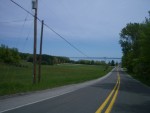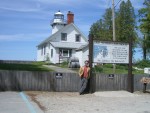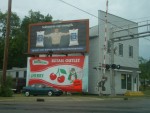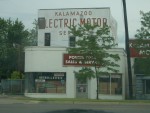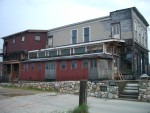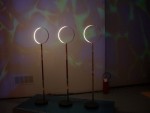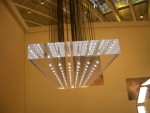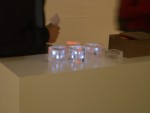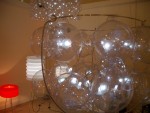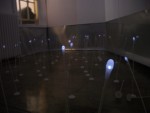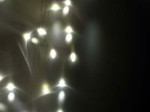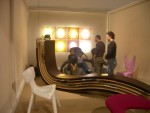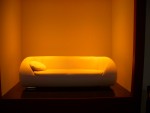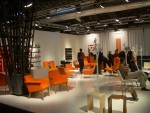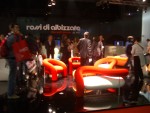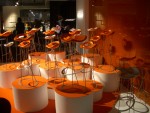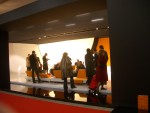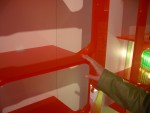May 31, 2004
Greetings from the Great Lakes State
I'm on vacation in Michigan, visiting the folks, the dog and the state I moved away from. Most of my time is spent in Ann Arbor, but I also got to spend a little time in Traverse City up north and Kalamazoo (as in "I got a gal in..."), in the middle-south of the state.
While we're on the Michigan tip, I would like to recommend Sufjan Stevens new record, who sings about Michigan a fair bit. Thought it's occasionally too wussy (learn some power chords, son!), it's good mellow folk rock.
May 27, 2004
Two Furniture Fairs (part 3)
One of my goals in going to Milan and New York was to see where the industry currently stood in terms of my smart furniture ideas. I mean, I'm an outsider, so who knows if I'm reinventing the wheel? If these fairs are representative, I may be barking up the wrong tree, but I'm not reinventing the wheel (if you know what I mean).
LEDs
Molly tells me that in Ivrea they have a (pejorative) saying about how others perceive interaction design: "If it has an LED, it's interaction design!" I think that's an accurate description of a stage of evolution in the design of products: LEDs are probably the easiest electronic component to incorporate into a design, so they get used first. For the most part, this is where furniture's state of incorporating information processing currently stands (for the most part). Most treat LEDs are replacement for miniature light bulbs, but it's a start:
There was also a nice LED lighting piece in New York by British designer Emma Caselton called "The Stretched Convention." I didn't get a picture of it. It featured columns and plates of LED's diffused by various fabrics. Very pretty and would make a good platform for ambient display. Emma sent me pictures!
Here's a speaker/light made by a Korean designer. The sound modulates the emitted light:
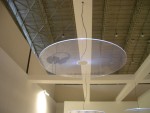
Element Labs presented a nice set of enormous LED tiles that can be stitched together into big walls of individually-addressable color blocks.
The best LED lighting piece, however, was in New York. "Lume," by Divalli, is a diffuser fabric with embedded LEDs. It was designed by some MIT people and the manufacturer and it looks like glowing, shimmer cotton batting (and they were savvy enough to vary the color temperature and spacing of the LEDs to give it a nice visual texture). The Globe and Mail provides good background. And, again, no pictures (on that note, if anyone in Bristol has found a Pentax Optio s4i digital camera, let me know… ;-).
Not an LED, but there was also this nice ironic light made from electroluminescent wire at the Milan Salone Satellite:
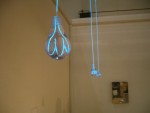
Smart Furniture (unironic)
Now to smart furniture. Frankly, there was very little. Between two massive shows, which probably featured 100,000 different furniture designs between them, I found two pieces. Maybe I missed some, so please send suggestions if you have any. Probably my favorite smart piece in the whole show was the table designed by RISD for their "Trace" restaurant design in the food design show in Salone Satellite (which I was so entertained by that I forgot to take pictures--doh!). Primarily a decorative piece, it used technology cleverly and transparently. Translucent tables had cameras mounted underneath them: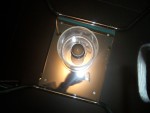 The images from the cameras, underneath shots of outlines of plates, silverware and hands, were projected onto the walls of the restaurant, subtly layered so that it wasn't obvious where the images came from. What I liked was that the piece worked when people didn't know how it worked or how to affect it, when they knew what it was, but not how they could change it and when they knew what it was and how they could affect it. That's pretty much the definition of how an ambient piece that extends the functionality of an existing object should work, which is what attracted me to it.
A similar idea was explored by Ivrea students, but in a more literal way, but with cameras above the tables:
The images from the cameras, underneath shots of outlines of plates, silverware and hands, were projected onto the walls of the restaurant, subtly layered so that it wasn't obvious where the images came from. What I liked was that the piece worked when people didn't know how it worked or how to affect it, when they knew what it was, but not how they could change it and when they knew what it was and how they could affect it. That's pretty much the definition of how an ambient piece that extends the functionality of an existing object should work, which is what attracted me to it.
A similar idea was explored by Ivrea students, but in a more literal way, but with cameras above the tables:
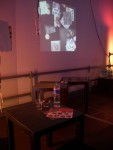
In New York, I saw what may be the first standalone piece of commercial smart furniture by Glide, a small design/consulting company. They have a cabinet that uses fingerprints and Bluetooth to lock and unlock a tabletop cabinet. It's a small step, but the design is clearly aiming toward high design esthetic (it has rounded corners and it's orange!), the technology is thoroughly integrated and the tech is clearly extending the base functionality of an object with an existing mode of use. I'm not sure how I would use it, but I was really excited to see it.
Smart Furniture (ironic)
Let me explain why I created this category: the majority of furniture design that incorporates information processing technology is heavily influenced by the work of Bill Gaver, Tony Dunne and Fiona Raby at the RCA and their critical design philosophy. I've said what I think about critical design before, so I won't again, but I still feel it important to put these piece in a section by themselves. OK, maybe one more thing: furniture fashion, like any other, depends not just on innovation, but on reference and context (as so painfully analyzed in Barthes Fashion System). Irony and commentary are clearly part of that mix, but when the scale tips towards so heavily toward irony that nearly all else (like functionality) is secondary, it gets its own section. First up is Crispin Jones' Invisible Force table, exhibited in the Interaction Ivrea section. I like this piece a lot, primarily because it really extends the existing piece of furniture and because the craftsmanship really respects the original table from which it was made: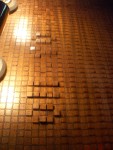
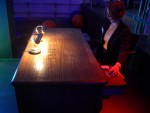
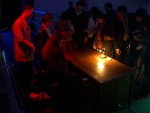
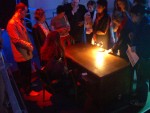
Some Ivrea students also made this great smart wallpaper as an ambient display medium:
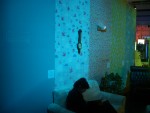
One stripe displays text by changing color (it's impregnated with heat-reactive dye and has small heating elements connected to a PIC behind it), another lets you change the brightness of a lamp (it uses small switches embedded in the paper), another changes color based on humidity and I can't remember what he final one does, but I liked it.
Finally, there was a great set of clever objects by Victor Vina and Hector Serrano, grouped under the name netObjects. These are a set of everyday objects augmented with technology, and as humorous objects of contemplation, they're great.
My favorites were a cuckoo clock that displays news, with a switch to choose between left wing or right wing news:
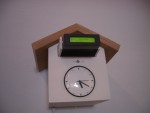
And an umbrella that shows weather forecasts:
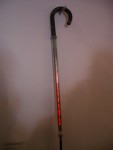
I think that all of these pieces point the way toward a whole new generation of furniture, a new way of thinking about how to use information. This may be the bleeding edge of the wedge (while we're mixing metaphors), but I'm incredibly excited to see this kind of work. I can't wait.
May 26, 2004
Two Furniture Fairs (part 2)
Rereading that last post, it seemed kinda grumpy. That's not actually representative of my experience. There was a huge amount at these fairs that I liked a of lot. Here are some notes about that.
Kitsch or classic?
One of the nicest surprises for me in Milan is that it's not just a contemporary furniture fair, it's a furniture fair in general, and there's a huge amount of non-contemporary furniture (the New York Fair is all contemporary). There's cheap anonymous furniture--terribly cheap furniture--hotel furniture (which is cheap and anonymous, but sturdy), there are companies that make futons, designers desperately hoping to get their pieces picked up, there's art by the square yard and six foot high handmade white and gold porcelain vases. Everything that's related to home furniture is there. Northern Italy, as I understand it, has the largest concentration of independent furniture makers anywhere on earth, and they get their own section.Then there's traditional old school furniture. Hand-carved wooden filigree and marquetry. Painstaking craftsmanship that's changed little in 500 years (well, maybe some power tools and acrylic). If contemporary furniture design is trapped in amber, traditional furniture design is intentionally petrified. It serves a market and lives in a parallel universe of its own. I found this fascinating, especially when those manufacturers decide to tackle new ideas, which sometimes produced seriously surreal results (and not in the Dali lip-couch sense, more like de Chirico and Miro):
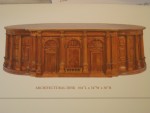
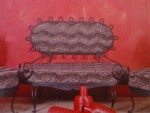
(the round table is by Buontalenti, a French/Polish company, but in the traditional Italian furniture section; the couch thing is by MetalChic)
Though contemporary furniture manufacturers come up with some pretty ridiculous designs, too:
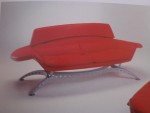
Food design
Continuing a show I saw advertised in Turin last year (maybe a dry run?) the Milan fair featured a special theme on food design, where designers and design schools were invited to redesign the whole food process, from the restaurant down to the actual delivery of the product.The Kono Pizza stand tried to reinvent the Italian classic as a combination wrap/ice-cream cone (but hot), and so had to reinvent the whole presentation of the product:
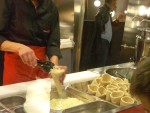
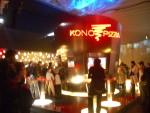
There was also a solid coffee bar (yes, the coffee was solid, though I didn't see it being delivered, so I don't know how solid), which I didn't get pictures of.
This wine store used wine bottles as walls, which I liked:
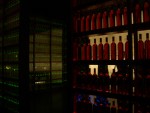
However, a croissant shop in a disco doesn't really work for me:
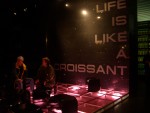
(and how is life like a croissant? Flaky and twisted?)
At the Salone Satellite, an adjunct to the main fair where independent designers exhibit, a number of design schools from various countries created restaurants. Maybe I'm projecting, but it was interesting to see how national character permeates design (maybe intentionally).
The Osaka University of the Arts' pizza restaurant looked more Japanese than Italian:
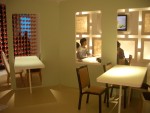
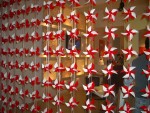
Trace, an installation from RISD, was elegant, beautiful and (they being an American school), firmly grounded in technology. Though I clearly enjoy the technology, I realize that it reflects American technolphilia. This was clearly apparent in how the presentations of Design Academy Eindhoven and Art Center students differered when they showed their work at the Metropolis conference in New York. The Dutch students spent a week collecting street trash and making stuff from it, and were quite proud of the fact that their students could sew, knit and didn't rely on computers. Art Center's students presented much slicker (though not necessarily better designed) and commercial work, but all their work was clearly only possible to manufacture with computers. I think both positions reflect a kind of willing blindness that's too limiting, but it's interesting to see how cultural it is.

The Japanese restaurant by the University of Art and Design Helsinki seemed to be a lot more about evoking Finnish cold than evoking Japan:
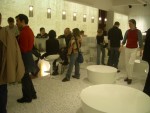
And the Jerusalem-based Bezalel Academy of Art and Design's French restaurant was called "Partingline" and featured a harsh bisection of the space, with divided plates, seats (that only worked when both parts were used) and a bisected space:
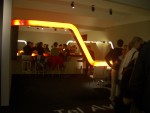
Food gadgets
Some ideas are so good, they get to be invented twice. At opposite ends of the Milan fair: cake plates with marks to indicate where to cut to get a given uneven number of slices: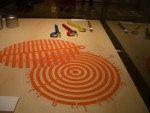
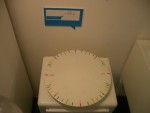
I also liked this set of as sushi utensils made to look like pieces of sliced-up mugs (from the Finnish design school restaurant):
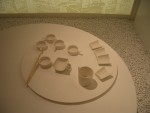
Favorite things
In terms of furniture, my favorite stuff in both shows came from the experimental, more techie side of things.
A screw Bookshelf by Rose Cobb:
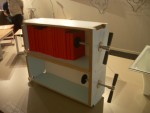
A heated concrete couch (by three Swedish designers).
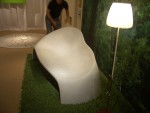
Molly fell in love with this lamp at first sight and bought it on the spot. Though I like the design, I'm really excite because of what it means for mass-market customization. It's printed using a polyester rapid prototyping printer, which means that--theoretically--each one can be different, since they're grown individually. In fact, they include a disk with the lamp design as part of the purchase package. Molly named it "lampy":
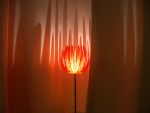
Stools made of old skis by defyra (from the excellent designersblock show, which probably had the highest density of smart, original design of anywhere in either the Mlan or New York shows):
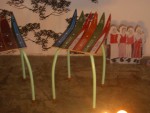
Of course one of my favorite things was experiencing all of the materials. In New York I got to see the amazing transparent concrete everyone's been talking about, and a beautiful murky green plastic with embedded grass which looks like you're swimming through the reeds in a pond, and chain mail made of ceramic rings.
The Side Show
Finally, the weird stuff. It's easy to pick on people for using improper English when trying to look cool, but there was some very amusingly nonsensical copy, which made no sense regardless of the language it was written in: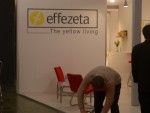
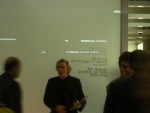
And some installations were, well, indescribable. It's not clear what the exhibit designers were thinking when they made an S&M dungeon living room:
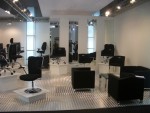
Or this 1970s concept kitchen (look, orange! and, OK, it was the 70s…):
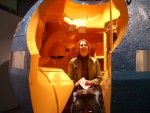
Or this pretty, if impractical, concept design from a Ukranian (I think) design school:
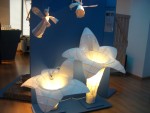
Or this one, from the same show:
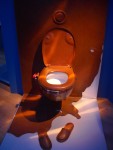
And I still don't know what this was about:
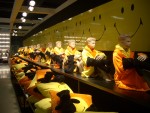
Tomorrow, or soon: the smart furniture!
(also, apologies to all of the designers whose work I'm showing without attribution, I was mostly snapping pictures and not taking too many notes, so please excuse me--if you see this all tell me where to link for any of the things I've mentioned, I'll be happy to put in a link)
Two Furniture Fairs (part 1)
Since my furniture manifesto was being published, I decided to learn something about the furniture business by diving into the deep end. In April, I went to the Milan Furniture Fair (the Salone Internazionale del Mobile) and then International Contemporary Furniture Fair in New York in May. It's hard to distill these enormous fairs into some blog entries, but here are some thoughts/observations. For those who are in the business who may be reading this, excuse me if I state the obvious or jump to conclusions.
The first thing that surprised me was how enormous and fragmented the industry is. Here's a map of the Milan center that hosts the Salone. It's probably half a square mile in area and on multiple floors:
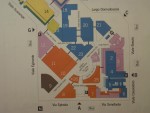
The second thing that surprised me was how much of furniture is fashion. It's obvious in retrospect, but I'm new at this and previously was only exposed to high design furniture in magazines and stores, I had expected a deep culture of innovation. The reality is expectedly more mundane. The majority of companies and designers are not trying to push any boundaries, but to create the most "now" pieces, the ones that look the most like the archetypes of what "today's" fashion is supposed to be. This leads not to innovation, but nearly stultifying repetition, and that's fine--when any consumer-products industry is seen this way, I suspect it's like this.
High design is a miniscule part of the market, as can be expected (and as Capellini, one of the touchstones of contemporary Italian avant garde design, found out a difficult place to make money).
In terms of identifying the fashions, there were several notable themes:
Corners!
This is the most high-design of the current styles. A major furniture fashion trend is the use of massively rectilinear low, flat, Japanese-influenced elements, often pairing dark woods or woods with obvious grains with chrome. Most of this stuff is in shades of brown and, frankly, I think a lot of it is quite elegant and beautiful, but it's overwhelming and so cold. Presumably the wood grains and earthtones are designed to soften, warm and humanize the cold designs, but they really don't. It all still comes off as looking like you're living in a metal shop: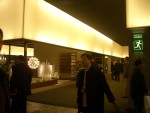
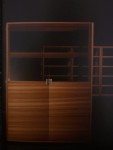
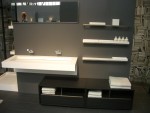
(the first image is from the Cecchini Collection.)
Molly and I saw a more mass-market version of this when we stayed in a recenty-revamped Business Class room (which, in itself, is a clever remapping of airline terminology to hotel rooms) at the SAS Radisson in Oslo. However, in practice it turned out to look more low-rent than it did in the showrooms, which is kind of a testament to how easy it is for this style to degrade to formica+chrome.
Rounded corners!
As a culture, the furniture design culture seems to be recycling Modernism. It's not just stuck in the Bauhaus agenda of expressing material properties through design, but a rampant copying of the Midcentury designers who embraced these ideas. Molly and I counted 4 design-patent skirting variations of Mies' Barcelona chair [link], and we probably passed 10 more. I'm not sure I want to dig into the explanation of this entrenched nostalgia--conservatism masked as avant garde--but it pretty much rules.(I don't have any pictures of these pieces because, well, we've seen them all before and I didn't think to take any)
No corners!
Globular biomorphism is the opposite end, and seems to be prevalent in funky office design: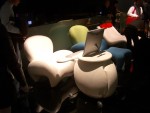
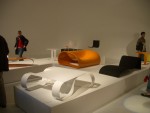
Orange!
As red is the third color (after black and white--in language, art, politics and printing), orange seems to be the fourth when it comes to furniture design. I thought that the International Council--or whatever that organization is called--said that Orange=1998, but clearly not here. It's in full flower.Form follows fashion
One obvious trend in furniture design that defines it as primarily fashion-driven, rather than function-driven is the amount of terrible, uncomfortable furniture that looks good.Here's Molly trying out a plastic foldable bench/couch:
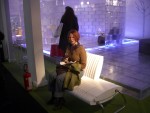
Here's a wall-mounted plastic tet-a-tet couch thing that is an interesting use of injection-molded plastic, but looks nothing so much as an enormous urinal, and is about as comfortable to sit in:
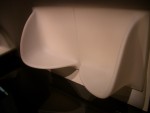
(and props to Henry Petroski and his excellent book The Evolution of Useful Things for the "form follows fashion" phrase)
"Do not sit on couch"
One very pleasant surprise about the design show is that everyone touches everything. So much of the design is tactile that people touch, poke and caress everything and--unlike museums and snooty design stores—it's encouraged. So I had a great time touching stuff and feeling materials directly, which was great.May 15, 2004
How did that happen?
It was supposed to be an appliance design conference, but there was this reception and there was champagne and, well, I don't really know how I ended up wearing a jester at Thornbury Castle...
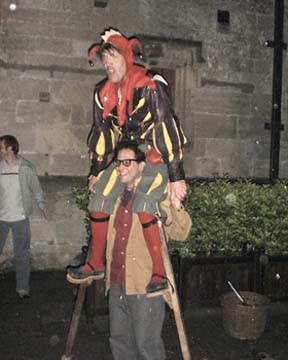
(thanks to Rachel Eardley for the photo!)
May 12, 2004
Smart Furniture Side Show
I've been bouncing around Europe, going to various conferences and hanging out with Molly. My brain is full of amazing impressions and my notebook is full of ideas. I'll (hopefully) be updating the site when I get to Ann Arbor toward the end of the month.
Today I'm at 2AD, the Appliance Design Conference in Bristol and it's really great. I'm doing the Smart Furniture Side Show, where I'm talking about my ideas and the second version of the Manifesto (which is going to be in the June issue of Metropolis Magazine--look for it!).
I'm also heavily relying on several amazing posters designed by some very talented friends of mine on very short notice: Ranjit Bhatnagar, Brady Clark,Terry Colon and Sonia Harris (who burned the midnight oil pulling everything together--thank you, Sonia!).
Here's Sonia's rendition of the v2.0 Manifesto, in glorious printable large format PDF to decorate your cube with (or throw darts at...whatever):
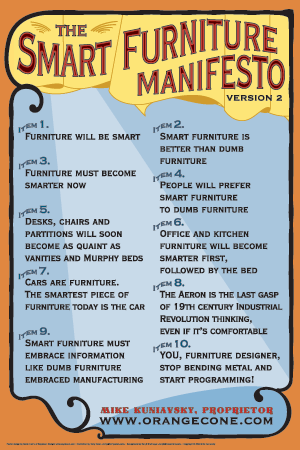
(290K PDF)
[Poster picture/PDF added 5/25/04]

